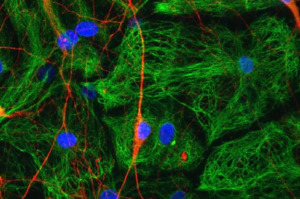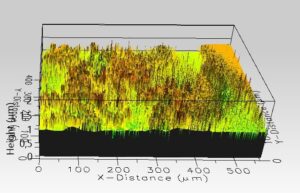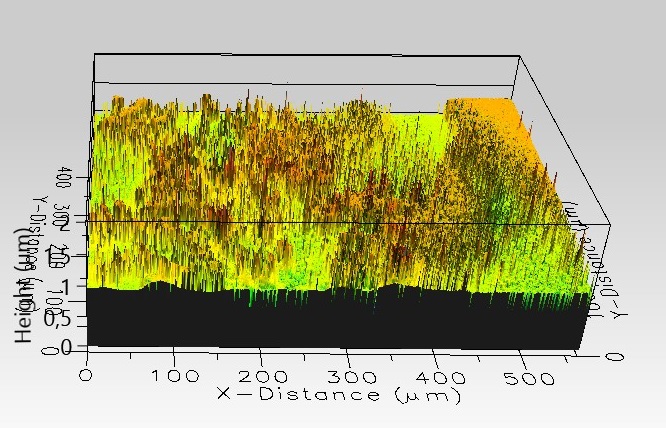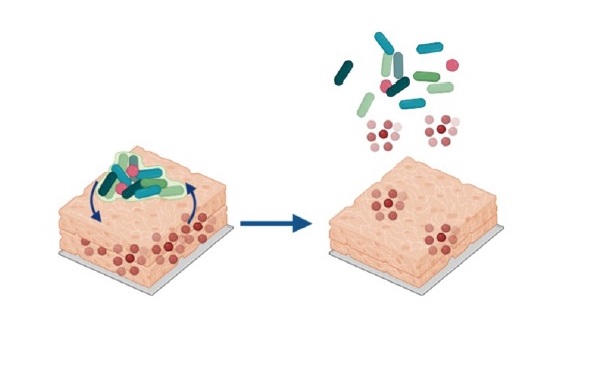Start - Bioelectrochemistry areas
Bioelectrochemistry Group carries out research work at the Center for Organic and Nanohybrid Electronics, Center of Biotechnology, as well as at the Department of Physical Chemistry and Technology of Polymers, Faculty of Chemistry, Silesian University of Technology. The main areas of research interest include the use of electrochemical methods to study biological systems, electrochemical synthesis of coatings and surface functionalization of biomedical devices, development of controlled drug delivery systems and the design of biomaterials. Group members have access to electrochemical, microbiological and molecular biology laboratories.
Neural tissue engineering

Neurological disorders are the third most common cause of disability and premature death in EU, and the number of patients is expected to grow intensively over the next years. The most common neurological disorders are associated with the malfunction in the delivery of neurotransmitters – chemical messengers that transmit a signal from a neuron across the synapse to a target cell. For instance, epilepsy, Parkinson’s and Alzheimer’s diseases are related to the defects in neurotransmission of gamma-aminobutyric acid, dopamine or acetylcholine, respectively. Current therapies for these disorders include the use of biologically active compounds, which regulate the secretion of particular neurotransmitters. Unfortunately, the common limitation of this approach is the fact that drugs are administrated systemically, so may affect the whole organism with serious side effects.
The aim of our research is to design a library of electroactive materials that could serve as a neural support for cells and controlled drug delivery systems.
Selected publications:
- Krukiewicz K., Czerwińska-Główka D., Turczyn R., Blacha-Grzechnik A., Vallejo-Giraldo C., Erfurt K., Chrobok A., Faure-Vincent J., Pouget S., Djurado D., Biggs M.J.P.: Flexible, Transparent, and Cytocompatible Nanostructured Indium Tin Oxide Thin Films for Bio-optoelectronic Applications. ACS Advanced Materials and Interfaces 15 (2023) 45701–45712.
- Smołka S., Skorupa M., Fołta K., Banaś A., Balcerzak K., Krok D., Shyntum D.Y., Skonieczna M., Turczyn R., Krukiewicz K.: Antibacterial coatings for electroceutical devices based on PEDOT decorated with gold and silver particles, Bioelectrochemistry 153 (2023) 108484.
- Imae I, Krukiewicz K.: Self-doped conducting polymers in biomedical engineering: Synthesis, characterization, current applications and perspectives, Bioelectrochemistry 146 (2022) 108127.
- Vallejo-Giraldo C., Krukiewicz K., Biggs M.J.P.: Understanding the Mechanobiology of Gliosis May Be the Key to Unlocking Sustained Chronic Performance of Bioelectronic Neural Interfaces, Advanced NanoBiomed Research 2021, 2100098.
- Czerwińska-Główka D, Skonieczna M., Barylski A., Golba S., Przystaś W, Zabłocka-Godlewska E, Student S, Cwalina B, Krukiewicz K: Bifunctional conducting polymer matrices with antibacterial and neuroprotective effects, Bioelectrochemistry 144 (2022) 108030.
- Skorupa M., Więcławska D., Czerwińska-Główka D., Skonieczna M., Krukiewicz K.: Dopant-Dependent Electrical and Biological Functionality of PEDOT in Bioelectronics, Polymers, 13 (2021) 1948.
- Czerwińska-Główka D, Przystaś W, Zabłocka-Godlewska E, Student S, Cwalina B, Łapkowski M, Krukiewicz K: Electrically-responsive antimicrobial coatings based on a tetracycline-loaded poly(3,4-ethylenedioxythiophene) matrix, Materials Science and Engineering: C 123 (2021) 112017. DOI: 10.1016/j.msec.2021.112017
- Krukiewicz* K, Britton J, Więcławska D, Skorupa M, Fernandez J, Sarasua JR, Biggs MJP: Electrical percolation in extrinsically conducting, poly(ε-decalactone) composite neural interface materials, Scientific Reports 11 (2021) 1295.
- Tadayyon G, Krukiewicz K, Britton J, Larrañaga A, Vallejo-Giraldo C, Fernandez-Yague M, Guo Y, Orpella-Aceret G, Li L, Poudel A, Biggs* MJP: In vitro analysis of a physiological strain sensor formulated from a PEDOT:PSS functionalized carbon nanotube-poly(glycerol sebacate urethane) composite, Materials Science and Engineering C, 121 (2021) 111857.
Surface biofunctionalization

Rapid growth and development at the intersection between electronics, engineering, biology and medicine has allowed for the creation of a new discipline, bioelectronics. Serving as the translators between the signals and functions of human body and external electronic processing systems, bioelectronic devices allow for the sensing, recording and monitoring of physiological states, as well as for their regulation. Bioelectronic devices can be already found in numerous applications, especially in neural tissue engineering as cochlear implants, neural stimulation devices to treat epilepsy or paralysis, and deep-brain stimulation devices to treat Parkinson disease. Although being a mature technology, bioelectronics still needs to face several challenges, including the implant-associated inflammation and scaring limiting the performance of the devices. Consequently, intensive research efforts have been made to develop advanced materials possessing superior electrochemical properties and biocompatibility.
The aim of our research is to expand the currently existing library of surface modifications suitable for use within bioelectronic interfaces by developing biofunctionalized organic monolayer coatings. The coating are based on electrodeposited monolayers, which form thin uniform film over the whole surface of electrode significantly changing its physicochemical properties and biocompatibility. By the further surface modification of as formed coatings through biologically active molecules, we have assembled a versatile toolbox of coatings for addressing a variety of challenges related to the interface between biology and electronic systems.
Selected publications:
- Patel T, Skonieczna M, Turczyn R, Krukiewicz K: Modulating pro-adhesive nature of metallic surfaces through a polypeptide coupling via diazonium chemistry. Scientific Reports 13 (2023) 18365.
- Krukiewicz K., Czerwińska-Główka D., Turczyn R., Blacha-Grzechnik A., Vallejo-Giraldo C., Erfurt K., Chrobok A., Faure-Vincent J., Pouget S., Djurado D., Biggs M.J.P.: Flexible, Transparent, and Cytocompatible Nanostructured Indium Tin Oxide Thin Films for Bio-optoelectronic Applications. ACS Advanced Materials and Interfaces 15 (2023) 45701–45712.
- Smołka S., Skorupa M., Barylski A., Basiaga M., Krukiewicz K.: Improved adhesion and charge transfer between PEDOT:PSS and the surface of a platinum electrode through a diazonium chemistry route, Electrochemistry Communications 153 (2023) 107528.
- Patel T., Skorupa M., Skonieczna M., Turczyn R., Krukiewicz K.: Surface grafting of poly-L-lysine via diazonium chemistry to enhance cell adhesion to biomedical electrodes, Bioelectrochemistry 152 (2023) 108465.
- Patel T., Huang J., Krukiewicz K.: Multifunctional organic monolayer-based coatings for implantable biosensors and bioelectronic devices: Review and perspectives, Biosensors and Bioelectronics: X, 2023, 100349
Microbial electrochemistry

It is a natural tendency of microorganisms to attach to wet surfaces and form a slimy matrix composed of an extracellular polymeric substance, known as a biofilm. Since the formation of biofilm is a common phenomenon, it has a significant influence on a broad range of industrial areas, including chemical industry, construction industry, machine industry, food industry, cosmetic industry and medicine. For instance, the formation of biofilm may result in the contamination of food products and medical devices. On the other hand, the presence of biofilm may be required for the proper functionality of microbial-based technologies, e.g. microbial fuel ells or microbial-based supercapacitors. Therefore, the ability to control the formation of biofilms is highly required.
The aim of our research is to design a novel type of electroactive coatings than can be used to control the growth of biofilm. The investigated coatings are based on conducting polymers, which are known to have tuneable physical properties and morphology depending on their oxidation state. Conducting polymers can be also used as carriers for different biologically active compounds, e.g. antibiotics or pro-adhesive agents. If stimulated with electricity, conducting polymers are able to release these compounds in a highly controlled way, modulating the attachment and viability of bacteria.
Selected publications:
- Abdullah, Krukiewicz K. Development of Electrically-Conducting Biohybrid Materials Based on Electroactive Bacteria and Conjugated Polymers: Review and Perspectives. Electrochimica Acta 468 (2023) 143191
- Smołka S., Skorupa M., Fołta K., Banaś A., Balcerzak K., Krok D., Shyntum D.Y., Skonieczna M., Turczyn R., Krukiewicz K.: Antibacterial coatings for electroceutical devices based on PEDOT decorated with gold and silver particles, Bioelectrochemistry 153 (2023) 108484.
- Krukiewicz K., Kazek-Kęsik A., Brzychczy-Włoch M., Łos M.J., Ateba C.J., Mehrbod P., Ghavami S., Shyntum D.Y.: Recent Advances in the Control of Clinically Important Biofilms, International Journal of Molecular Sciences 2022, 23(17), 9526.
- Karon K., Zabłocka-Godlewska E, Krukiewicz K.: Recent advances in the design of bacteria-based supercapacitors: current limitations and future opportunities, Electrochimica Acta 430 (2022) 141068
- Czerwińska-Główka D, Skonieczna M., Barylski A., Golba S., Przystaś W, Zabłocka-Godlewska E, Student S, Cwalina B, Krukiewicz K: Bifunctional conducting polymer matrices with antibacterial and neuroprotective effects, Bioelectrochemistry 144 (2022) 108030.
- Czerwińska-Główka D, Przystaś W, Zabłocka-Godlewska E, Student S, Cwalina B, Łapkowski M, Krukiewicz K: Electrically-responsive antimicrobial coatings based on a tetracycline-loaded poly(3,4-ethylenedioxythiophene) matrix, Materials Science and Engineering: C 123 (2021) 112017.
- Czerwińska-Główka D., Przystaś W., Zabłocka-Godlewska E., Student S., Cwalina B., Łapkowski M., Krukiewicz* K.: Bacterial surface colonization of sputter-coated platinum films, Materials 13 (2020) 2674















